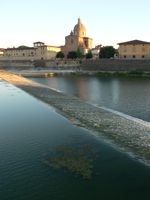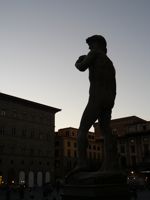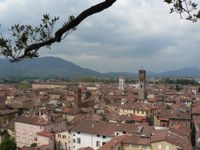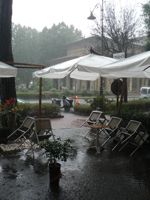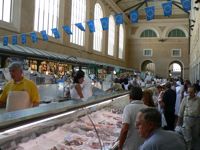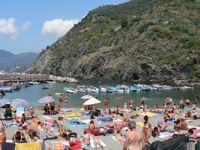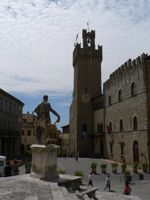We wish to learn all the curious, outlandish ways of all the different countries, so that we can "show off" and astonish people when we get home. We wish to excite the envy of our untravelev friends with our strange foreign fashions which we can't shake off. ... The gentle reader will never, never know what a consummate ass he can become, until he goes abroad. I speak now, of course, in the supposition that the gentle reader has not been abroad, and therefore is not already a consumate ass. If the case be otherwise, I beg his pardon and extend the cordial hand of followship and call him brother.
--- Mark Twain, The Innocents Abroad
Now you know why we use the local names for places...
Firenze (aka Florence)
August 3rd to 5th
So we finally made it to Tuscany, as long as you discount travelling over it by plane and train, deciding on a quick visit on the way to a Muse concert in Verona's 2500 year old pink marble arena, and a day trip to Siena. This is the "official" start of the Tuscany sojorn. After bolting slowly out of the Umbrian south, we had a two-hour train ride to Firenze, otherwise known as Florence, former home of the Medicis and Michelangelo.
We arrived late on the 3rd, and Hal did her usual trick of finding a hotel, while I did my usual trick of looking tall and guarding the luggage. Actually Hal is getting very good at communicating with the natives. My parents, when they visited in Umbria brought with them a couple of Italian verb and grammar books, which Hal has actually been reading. I'm still carting around my Melbourne tourist language course notes, which I haven't been reading. Hal is working out the tenses and gender and repeatedly getting long streams of fast, complex Italian hurled at her. I am still working out the difference between adjectives and proverbs in English. Still, apparently I have one word over Hal: at the end of a meal I ask for the bill (conto) whereas Hal often asks for the discount (sconto). I'm not sure if I can even count that as a win.
After settling in, we went for a wander to find the local Mac store, in an attempt to get my computer working after two months of being in hardware "repair". (Yes, it is irritating that I keep talking about this, but at least this gives me the opportunity to point out that this Tuscan section is being worked on in almost real-time now. Previous regions rely more on the fiction that my memory presents as the past, or simply have not been written.) We explained the problem to a gentleman that I've never seen who gave us a copy of the operating system to reinstall on condition that we'd never seen him. I still haven't. This little journey did put us in the region of the old fish markets, which included a covered area converted into a bar. They were apparently rescued and moved from another location, required, obviously, for building the Piazza della Repubblica. We had a couple of beers there before heading to a restaurant recommended by an Ultimate friend, Jess, who undertook a postdoc in physics in Firenze. A very good choice, especially the pizza with Buffalo mozzerella and baby tomatoes.
Two things stood out immediately about Florence. It's flat unlike most of Umbria where we'd spent the previous two months, and it has a vibe similar to inner city Melbourne. Lots of bars and restaurants. What it has over Melbourne in spades is art, which we would get to the next day, and the subsequent hordes of tourists.
The next morning we were up early and heading straight for what I consider to be the best attraction in Florence: The David. Now I think there are something like ten Davids in the Division in which I work, none of whom prepares you for what you are to see. The David is a monolithic work, now 500 years old, that has been touted as the completion of sculpture as a medium. 5 metres tall, studies have shown that Michelangelo has created a perfect replica of a human just after the exhertion of battle. There is only one fault, apparently somewhere near the small of the back, due to the condition of the stone and noted by the man himself. Simply stunning. You of course are not allowed to take photos, which is why people walk past the no photo signs and take a photo with their phone. One of the more irritating habits of the touristing crowd. I took my revenge by taking a photo...
The museum also houses a number of Michelangelo's uncompleted works which resemble figurines exploding out of the marble from which he was carving. While we were there they had also augmented their usual collection of musical instruments -- including the only remaining Stradivarius (sp?) unaltered tenor viola in existence -- with a range of musical instruments made out of unusual yet expensive substances. These included a marble guitar and a marble harpsichord. Hal was in heaven.
The rest of the day was fairly dull in comparison. The multi-layered marble Duomo (we didn't go into the Bapistry again), Piazza della Signoria (we didn't go in to the Uffizi again), the food markets, Cappelle Medicee with more statues by the big M, the Ponte Vecchio, outside the Palazzo Pitti, almost into some gardens which turned out to be private and huge, and finally a bar, Mammas, also a recommendation from Jess. The markets were fabulous, and included one location where we had lunch, mostly pork grilled and roasted and a couple of glasses of wine. The Medici Chapels I would also recommend so you can get a taste of how sodding rich these bastards were. You can also pay homage at their tombs, particularly Ferdinando who patronised some dude who basically invented the piano. Not bad for a guy who we think died of syphillis after a probably memorable trip to Venice.
Lucca
August 5th to 9th
One of our final acts of revisiting, we made our way to Lucca, a place we had visited during a trip in 2005 that combined Hal's mid secondment return home trip and the continuation of my trip to the USA and Canada for Julie and Derek's wedding. On their suggestion I believe, along with their company and that of Simon and Kerrie, we had first visited this walled township. We had thus returned on account of it being very cool. The city of one hundred churches, apparently, we wasted little time verifying the fact. It used to be involved in various conflicts and rivalries with Siena, Pisa and of course Firenze. The Medicis probably beat them up. At some point they decided huge -- and I mean fuck-off huge -- walls would be great protection. They were once, but only for floods when Napoleon's sister was in charge. The city also gave birth to the very Tuscan cuisine of a half deep fried salami, hit before serving with a wooden mallot. (The last bit of course is a lie -- that was the Welsh -- but the rest of it is true.)
After dragging bags through the streets we made our way to the same hotel as last time, with the same frescoed room. They have better rooms, but we simply couldn't justify the expense. And so we camped for four nights. Roughing it as it were. There really isn't a lot more to say about the place other than to talk about the food, and I've abdicated all responsibility for that to Hal. We walked through the maze of streets on numerous occasions and ventured forth for food and drinks, mainly cursing the large numbers of tourists that we were contributing to. That is, of course, okay on account of that being "them" and not "us". It is similar to driving: anyone driving slower than you -- such as an L-plater -- is an idiot, and anyone driving faster is a moron. We have similarly cursed the loud, the North Americans, the British and the the Australians, not to mention the Italians. Idiotic morons the lot of them. Except the nice ones like us.
One thing about Lucca, other than it's walls, are it's towers. They are quite stunning, steep and pricey. One of particular note, which we did go up this time, has "self-seeded" oaks on top. Stunning views, although I'll be buggered if I can work out how they could spot any encroaching army from them. They were probably more like the towers in Bologna: symbols of status and wealth (and compensating for something).
When we left Lucca, there was a sense of calm. That could also have been the sensation of finishing dragging suitcases over cobbled streets. We however had no further plans on where we were planning on heading in Italy, other than our tickets out of the country from Sicily to Holland. We headed to Pisa...
Montecatini Terme
August 8th
The one place we did head for from Lucca was shortly named Montecatini Terme. This is a spa resort from the 20's, which has had numerous famous visitors, including Mr Woody Allen (the only one I can remember). The town has been built up in Art Deco style and was completely different from anything else we had seen. Worth a visit and probably worth a spa too. We went for the sauna style treatment. It is similar in cost and style to Daylesford, but older and surrounded by bad Italian architecture.
We had a brief wander through the town before heading for our spa. We had intended on a similar wander to look at the older spas, which are stunningly set up as large roman-style baths. Unfortunately it rained. Torrential is one word for it. It started and we headed for a cafe, to be subsequently flooded in as the path turned into a river. Quite the interlude.
Pisa
August 9th to 16th
It is probably worth mentioning at this time that Italy is a land of produce. This is particularly evident around rail lines: the land next to the track is often reclaimed by locals and various vegetables are growing, not that I know whether this reclamation is by legal title or by default. I was impressed by the pigeon coop though. And generally the land you travel through by train is cultivated. Around this time the corn is maturing, the wheat has been harvested and the fields replowed, tabacco hasn't been seen for a while, and the sunflowers are slowly dieing and blackening where they stand, defying our desire to know exactly how these monsters are harvested. Occasionally larger fields of vegetables are evident, but generally we are treated only to smaller plots of tomatoes, pumpkins and potatoes. And pigeons. The line to Pisa is no different.
Ah Pisa! We've been told that it is one of the most visited places in the country and the Leaning Tower is definitely known by most. We've also been told that the rest of Pisa is not worth looking at. A fair summation given that it was bombed heavily during the war. We were ready to keep an open mind about the place, but most places were shut for the summer break. A bar we wanted to try: shut. An internet place that was open one day was shut the next for a week. It made for an interesting view of the town.
Hal displayed her usual brilliance and found us accommodation for the night near the train station, which reduced lugging of luggage, and then a slightly dodgy apartment for the rest of the week, also with minimal lugging requirements. We reduced our expenses by buying a Hubert -- every 2.5 kilo fresh chicken we now purchase is called Hubert, Hubert II, Hubert the Revenge and such like -- and other foods, thus giving us a break from the typical Italian cuisine. I do have a hankering for other foods. I know Hal wants to try fritto misto (tempura-style offal selection) when we get to Rome, but I'm hoping to find decent Asian of any form.
Livorno (aka Leghorn)
August 11th and 15th
An advantage of staying in Pisa for a week close to the train station is that it is easy to travel elsewhere. Admittedly there are not a lot of places easily accessible, but we did make it to Livorno. A port city which grew greatly in the 1800s it was bombed heavily during WWII for being a facist stronghold. It is still an important port, with an area called Little Venice due to it's canals, it has quite the fishing community and is one of the main ports for getting to Elba.
We, of course, went for the food. A short trip from Pisa through swamp land put us at the station, which was a quite stunning piece of 19th century architecture. Modigliani was born in the town and some of the decorations seemed to be a tribute. Or maybe I'm shit at art appreciation. We walked into the centre of town past two parks with ponds and turtles to nourish Hal's turtle habit, passed the central square which is basically a covered canal, and to the Mercato Centrale, a neo-classical and monsterous market. It was fantastic, but after wandering for a while through the usual stalls, including trippa butchers with parts of animals that I'm unable to identify, we were unable to find any fish. The fish market it turns out was tacked on the side later, but was sufficiently large with 30 odd stalls selling swordfish, cuttlefish, squid, plaice, anchovies, sardines, shellfish, crustaceans, and a multitude of other species. I particularly like the mix of small fish specifically for soup. It was a painful visit as we really couldn't carry a purchase given the temperature, let alone cook it in our pitiful kitchen.
We walked further to the water, stopped at a restaurant for a lunch of cacciucco and chianti, then weaved our way back to the station and home. I'll leave Hal to describe the food.
A few days later we returned to try one of the Pescerias that littered Livorno. We assumed these would be like the Umbrian Porchetteria, serving fish to go. Unfortunately we don't know: we passed half a dozen all of which were shut for the summer break or Wednesday or some holiday or something. We had to settle for another restaurant meal which, although excellent, was irritating for charging a seating charge and then 10% of the bill. Another slow wander around the ex-fortress cum gardens cum cat home, we headed for the second train station -- listed on the ticket machines -- to find it closed down, and resulting in us wandering back to the first. The best laid plans...
Cinque Terre
August 14th
Another side-trip took us out of Tuscany and into Liguria and La Spezia and on to the incredible marine and land park that is the Cinque Terre. If you get the chance it is definitely worth visiting: five towns neatly placed on a sea cliff, nestled amongst ancient terraces of lemons and olives. The towns are stunning, the sea is stunning, and the shore is packed with people baking themselves stupid. Having been there before we started at Manarola and walked back to Riomaggiore, caught the train to Vernazza for lunch and a swim and then on to Monterosso for a couple of drinks at one of the enotecas, passing as we did so the baking millions. Lunch was expensive but the swim was excellent: the water warm and the fish feisty (okay I got nibbled). A wonderful way to pass an afternoon.
Arezzo
August 16th to 19th
Our next planned destination was Siena, but there was a slight problem. The night of leaving Pisa turned out to be the night of the Palio in Siena, which would mean an accommodation nightmare. The Palio is where 10 of the 17 districts race horses three times, bare back, around the Piazza del Campo. The ten are selected from the seven not to race previously and three chosen randomly. They select ten horses which are then drawn by lot by the participating districts. It is not the rider that needs to finish, but the horse, and once the race is underway anything goes except pulling another rider's reins. Thousands cram into the centre of the square and the cafes around the outside charge extortionate rates for seating. The race, which we watched safely from our hotel room in Arezzo, lasts about three minutes, including crashes.
Arezzo is another slight hilltown, taken over by the Medicis, producing lovely local wine and cheeses. Like Siena, they also have a local competition which, unlike Siena whose Palio has been running continuously, was revived in the 1930s. This involves jousting in the main square instead. Safer and probably more entertaining as it lasts longer. This is held in early September. We watched the previous one safely from the comfort of our apartment in Perugia in June. They like televising these things.
Arezzo is not that exciting but it is a beautiful location. In fact it was used extensively in the filming of "La Vita e Bella" or "Life is Beautiful", with the mad Italian that won the Oscar for best actor. The streets have a number of signs indicating film locations. The main fort was leased to someone to farm sheep in for a while, they have a post in the main square that they used to whip people against, a clock so unique that when completed they had the eyes of the maker put out so he didn't make another one. Just the typical sort of stuff. I highly recommend a visit if you get a chance.
Siena
August 19th to 21st
From Arezzo we caught a bus to Siena. Siena was still abuzz from the recent race. There were photos of the Unicorn district's win and flags everywhere. In fact they were still hosing out Il Campo to get rid of the sand that they packed the place with. Hal did the impressive hotel finding thang, while I did the lame bag guarding ... thing. It was humid and cloudy, and luckily we had been to Siena previously with Liz and Koen and had managed to take our quota of photos then. Dinner later was in the Goose district on a street with chocks under it's tables to make them level.
Our first full day we broke fast at Nannini, famous for it's water-cooled gelati fridge, powered by the kilometres of water tunnels constructed under the city, which you can't see. We visited Palazzo Communale next, taking in the frescoes from the 16th century and the more ellaborate, recent ones celebrating the unification of Italy. Siena got beaten up by the Medicis at some point and are particularly bitter about it. Evidence of their workings prior to this event were on display throughout the building. It would seem to me that one good reason why the Italians did not have the same influence in the New World etc as the Brits, French and Spaniards is that they were too busy beating each other up. They lived in fortified hill towns and threw rocks at each other until the Popes had all the money tied up in edifices glorifying God and themselves. This of course is simply an indication that I should spend some time reading European history.
The next stop was Santa Maria della Scala: the former hospital, and what we thought would be a quick tour prior to lunch. Seriously, if you ever think of going here, take a packed lunch and a ball of string. There is a museum in the second basement of winding tunnels containing Roman and Etruscan artefacts with minimalist signage. There is a basement level that contains a weird monastic group's chapel celebrating the dead, and the original plaster works for the fountain in Piazza del Campo. And the top level has the Mens and Womens wards, rooms of art and a single hall ellaborately frescoed showing the life of the hospital from the nnth century. God knows. I was getting confused by this point, dizzy, and weak from hunger. We escaped down the hill beside the stunning Duomo, had some pizza and retreated to our room for a rest. We only came out for food and the chance to see one of the largest wine cellars in the country, housed in the magazine cellars of the former fortress. I think Hal had a Chianti. I had a Brunello. I'm not sure whether this is another blend mainly involving Sangiovese or is an actual grape variety. I'm leaning towards the latter, although it is impossible to tell with the labelling, especially because it is in Italian. Selfish, but the wine was very tasty.
Montepulciano
August 21st to 22nd
We escaped Siena by catching a bus to the train station and squeaking in a connecting bus -- go figure -- to Montepulciano, no thanks to the eminently punchable lady in the ticket office who refused to answer any question asked. Getting used to these buses, so I thought. The bus took us to the bus station out of town from which we caught the smaller bus that took us up to the Piazza Duomo. When I say "took" I mean transported us in the manner of a Six Flags hellride. Slowing down is for wimps, especially for prams and small children, buildings or anything else.
Montepulciano -- not to be confused with the grape variety from Abruzzo, I learned as Hal read something at me, disturbing my linear, guy focus on the one task I was trying to do at the time -- is a town in the wine growing region of Tuscany and famous for their Montepulciano wine made from Sangiovese. The town is also famous for it's reinstalled festival that involves rolling barrels through the town. We couldn't work out if that was uphill or downhill or both. The eight districts apparently compete in this, as you do. We were early and only managed to catch some flag throwing practices. The town is also built on the remnants of some Etruscan tombs, and has wine cellars squirrelled away under the streets. The Nobile blend was quite similar to the consistency that we've come to expect from Coonawarra wines. (God I sound like a ponce.)
Our hotel had a fantastic view of the Tuscan countryside, including the cathedral located just outside of town. We lobbed up, and waited for our red-headed twelve year old hotel operator. Hal was impressed that he filled out the receipt in my name even though she paid for the room. In fact that is something you encounter across the country. Regardless of the fact that Hal carries most of the cash extracted from her account and that she orders most of our food and wine, invariably I am given the wine to taste. What fun! Not only do I get to taste the wine without a sense of smell but I get the tirade afterwards. So moving on before Hal reads this...
Cheeky beggar! For the record, there are no tirades, just amusement/ bemusement. And I've still got the beer money...
Our afternoon in this odd hill town, involved wine tasting -- one of the few places that seems set up for this, cheese tasting, walking through wine cellars, and avoiding buses like the plague. Dinner was a place just around the corner from the hotel, which was an excellent choice if only for the comfy sofas and that it was pissing down when we left. Pasta, bresaola and fantastic red wine make for a great last evening in Tuscany.
Summary
Rating time! So again here are my purely scientifically validated and mathematically stretched ratings of each town:
- Firenze: four marble balls; you cannot get tired of this place.
- Lucca: three towers, reduced by the number of tourists you have to fight through.
- Montecatini Terme: three stars and an art deco fountain.
- Pisa: two stars and a cemetry.
- Livorno: three flakes and a calamari ring.
- Cinque Terre: four towns; the other one takes too much effort.
- Arezzo: three jousting sticks.
- Siena: three laps and a unicorn.
- Montepulciano: four glasses of Nobile.
